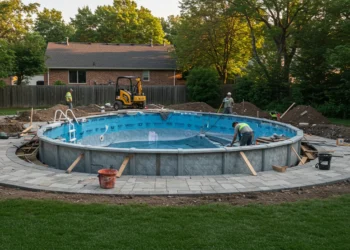Swimming pool ownership symbolises the pinnacle of leisure and luxury, but with this aquatic haven comes the responsibility of upkeep. A relatively unknown nemesis for pool owners is white water mould, commonly abbreviated as white water mould. Much like its terrestrial counterpart, pool mould thrives in damp, dark environments, but its presence in pools introduces a set of challenges unique to the aquatic setting.
If you’ve noticed your once-clear waters clouding, or worse, seen the telltale signs of a white, film-like substance on your pool’s surfaces, you might be facing a white water mould infestation. But don’t panic—this guide will equip you with the knowledge and strategies needed to fight back.
Understanding White Water Mould
What is White Water Mould?
An aquatic microorganism, it is a fungal-like growth that primarily affects pool surfaces and water quality. In its beginning stages, it resembles fine grains of white sand and can rapidly spread if left unchecked, forming into a gelatinous layer that clouds your pool water and clings to your pool’s liners, ladders, and toys.
How Does It Form and Thrive?
It flourishes when pool environments are not correctly balanced and maintained. Low chlorine levels, inadequate circulation, organic material in the water, or a mix of stagnant water and high humidity all create conditions ideal for white water mould to take hold. Once established, this mould can be notoriously difficult to eradicate, and can quickly become a recurring problem if the underlying issues aren’t addressed.
The Underlying Issues
Understanding the root causes of white water mould in your pool is crucial for effective and lasting treatment. It’s often a symptom of larger issues with pool maintenance or water chemistry that need to be rectified to prevent future outbreaks.
Detecting White Water Mould: The Early Warning Signs
Spotting it can be challenging at first, as its initial appearance may be mistaken for other forms of pool dirt. Look for these red flags that might indicate a white water mould problem:
A Shift in Water Clarity
If your typically clear water is showing signs of cloudiness or opacity, it can be a warning sign that something isn’t quite right in your pool’s ecosystem.
Residue on Pool Surfaces
A white, grainy residue on your pool’s surfaces, which feels slick to the touch, is a clear indication of white water mould presence.
Unexplained Pool Filter Issues
Are your pool filters clogging more frequently? White water mould could be the culprit, gumming up the filtration system and impeding water circulation.
The Widespread Impact of White Water Mould
Health Concerns
White water mould isn’t just unsightly; it can present health hazards, especially to those with sensitivities or compromised immune systems. In some cases, it has been linked to respiratory issues and skin irritations.
Structural Damage
The layer of white water mould on pool surfaces can be corrosive, damaging liners and making them more susceptible to tears and leaks.
Water Quality Compromise
Beyond aesthetics, white water mould can adversely affect the chemical balance of your pool water, requiring additional water treatments and increasing maintenance costs.
Holding Back White Water Mould: Proactive Prevention
Prevention is the key to managing white water mould. By establishing a robust pool maintenance routine and adhering to best practices, you can significantly reduce the risk of mould infiltration.
Maintain Proper Water Chemistry
Regularly test and balance the pH and chlorine levels of your pool water. A well-balanced pool is the least inviting to white water mould.
Enhance Circulation
Optimise your pool’s circulation system to ensure there are no stagnant spots where WWM can take hold and proliferate.
Sanitise Thoroughly
Implement a rigorous cleaning schedule with a focus on sanitising pool surfaces and keeping organic materials, such as leaves and grass, out of the water.
Positive Maintenance
Don’t wait for problems to arise before taking action. Perform regular, proactive maintenance to stay on top of potential trouble spots.
Also Know About Above-ground Swim Spa Landscaping Ideas.
Eradicating White Water Mould: A Step-By-Step Guide to Removal
Dealing with an outbreak of white water mould head-on is the best approach. Follow these steps to evict white water mould from your Factory Pools Perth fibreglass pool:
Assess the Extent of the Infestation
Start by examining your pool and assess the damage. Identify all the affected areas, from the surface of the water to the pool’s bottom and all the equipment in between.
Vacuum and Clean
Use a pool vacuum to remove as much particulate matter as possible. Ensure your pool’s filtration system is clean and functioning efficiently to prevent the spread of spores during the vacuuming process.
Choose Your Arsenal
Several commercial products are specifically designed to combat white water mould. Choose a treatment that aligns with the type of pool you have and the severity of the issue.
Shock and Awe
A chlorine shock treatment, usually at three to five times the normal dosage, can kill off the spores and neutralise the mould. Remember to follow the manufacturer’s instructions carefully to avoid over-shocking.
Brush It Off
Agitate the pool surfaces with a pool brush to dislodge and break up the white water mould. This will make it more susceptible to the shock treatment and give your filtration system a better chance to remove the debris.
Reassess and Maintain
After treatment, monitor the pool closely to ensure the mould doesn’t return. Continue with diligent maintenance to keep your pool mould-free.
Sustaining a Clean Pool
Regular Maintenance
Stick to a routine of regular maintenance, including cleaning, balancing chemicals, and maintaining your filtration system.
Invest in Prevention
Consider long-term solutions such as UV or Ozone systems, which can supplement your chemical treatments and inhibit mould growth.
Professional Inspection
If you’ve struggled with white water mould in the past, or are unsure if it has been fully eradicated, a professional pool inspection can offer peace of mind and identify potential risk factors.
Pool ownership is a rewarding experience, but not without its challenges. When it comes to white water mould, the adage “an ounce of prevention is worth a pound of cure” couldn’t be more true. By adopting a proactive approach to pool maintenance, understanding the signs and impact of white water mould, and responding swiftly and effectively when necessary, you can enjoy your pool to the fullest—clear skies, and clear water, for years to come.








